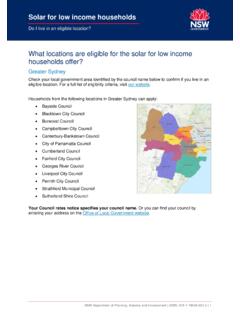Transcription of Deprivation and Education
1 The evidence on pupils in England, The evidence on pupils in England, Foundation Stage to Key Stage 4 Foundation Stage to Key Stage 4 Deprivation and EducationDEPRIVATION AND Education The evidence on pupils in England, Foundation Stage to Key Stage 4 Schools Analysis and Research Division, Department for Children, Schools and Families March 2009 2 3 1 INTRODUCTION 6 Deprivation and Education : why it matters 6 Effect on life chances 6 Substantial and pervasive impact from an early age 6 Policy context 7 Overview of the paper 7 2 Deprivation : DEFINITION AND MEASUREMENT 8 3 WHO AND HOW MANY ARE DEPRIVED 10 The proportion of pupils from deprived backgrounds 11 Eligibility for free school meals 11 Distribution of FSM pupils 12 Change in pupils FSM status 16 Pupil, school and area level Deprivation 17 Characteristics of pupils who experience Deprivation 18 Ethnicity 18 Special Educational Needs 21 4 IMPACT ON PUPIL ATTAINMENT AND OTHER OUTCOMES 23 Attainment 25 Overview of the FSM gap in educational attainment 25 Early years 26 Key Stage 1 to Key Stage 4 7 28 Changes in the FSM gap over time 32 Educational progress 34 Relative impact of FSM eligibility and prior attainment 40 Interaction with ethnicity.
2 Gender and other variables 41 An international problem 50 Attendance and exclusions 52 Attendance 52 Exclusions 56 5 WHY DEPRIVED PUPILS CAN FALL BEHIND 57 Explaining the association between Deprivation and poor outcomes 58 Income and material Deprivation 59 Health 60 Family stress 60 Parental Education 61 Parental involvement in their children s Education 63 Cultural and social capital, and the experience of schooling 64 Low aspirations 65 Exposure to multiple risk factors 65 Literacy 66 Change over time 66 6 THE SCHOOL EFFECT 67 The difference schools can make 70 In the classroom 71 Teaching quality 71 Pupil grouping 71 Assessment for learning 73 Curriculum 74 Homework and study support 75 Intervention for pupils who fall behind 77 Class size 79 School culture 80 Positive school culture 80 Attitudes, aspirations and expectations 80 Behaviour 81 Pupil voice 84 Transitions and decisions 85 Transitions between Key Stages 85 Pupil mobility 87 Choice of subject or qualification route 88 School size and resources 90 School size 90 School resources 91 Leadership.
3 Workforce and governance 93 Effective leadership in deprived contexts 93 Teacher turnover and qualifications 95 Wider workforce 96 Governance 97 Engaging parents and carers 98 Supporting pupils with multiple needs 100 National initiatives 102 Excellence in Cities 102 London Challenge and City Challenge 104 Extended schools 109 Academies 111 Building Schools for the Future 112 National Challenge 113 The Extra Mile 113 57 FURTHER QUESTIONS AND EVIDENCE GAPS 115 8 REFERENCES 116 61 Introduction This paper summarises research and statistical evidence on the subject of Deprivation and Education for pupils in Foundation Stage to Key Stage 4 in England, in maintained mainstream schools. Deprivation and Education : why it matters Effect on life chances The relationship between Deprivation and Education is crucial for understanding the significant impact Deprivation has on later outcomes in adulthood.
4 There is a very clear pathway from childhood poverty to reduced employment opportunities, with earnings estimated to be reduced by between 15 and 28% and the probability of being in employment at age 34 reduced by between 4 and 7% (Blanden, Hansen & Machin, 2008). Crucially, those who end up with lower earnings are those with a lack of skills and qualifications: in other words, Deprivation has a negative impact on educational attainment, leaving young people with fewer qualifications and skills which in turn affects future employment. Poor educational attainment has short as well as longer term consequences. There are direct effects on health (for example, quality of diet, chances of smoking) and indirect effects (for example, lower skilled people are more likely to find employment in hazardous occupations where they are at greater risk of accidents) (Feinstein et al. 2006). Indeed, Education has an impact on life expectancy: one more year of Education has been shown to increase life expectancy in the United States by as much as years (cited in Feinstein et al.)
5 , 2008). There is further evidence that lower levels of educational achievement can have a negative impact on an individual s engagement with society: for example, in the increased likelihood that an individual will engage in criminal activity (Feinstein et al., 2008). Substantial and pervasive impact from an early age Deprivation can have a large and pervasive impact on educational attainment. International data from the Programme for International Student Assessment (PISA) study of Organisation for Economic Cooperation and Development countries (OECD, 2006) shows that this is a widespread problem. Data from UK longitudinal studies have found that the impact of Deprivation on cognitive and educational measures is apparent from an early age. Using the 1970 Birth Cohort Study, Feinstein (2003) identified cognitive differences between children from different socio economic groups at 22 and 42 months, whilst findings from the Millennium Cohort of babies born in 2000 showed differences at age three (George, Hansen, & Schoon, 2007).
6 Not all children from deprived backgrounds will have lower than average attainment but Feinstein (2003) showed that, on average, even those children from lower socio economic groups performing well initially (at 22 months) were overtaken by others by the time they started primary school. These early differences were not appreciably reduced by entry into the schooling system (p89) and were found to be strongly associated with inequalities in educational outcomes in later life. The relationship between Deprivation and Education although inter related with other factors (such as maternal Education ) is an independent one. Low income has an independent effect on children s educational outcomes after controlling for measures of family background and child ability (Blanden and Gregg, 2004). Policy context There have been some key recent government and non governmental publications on child poverty which recognise the key role of Education , examining both the impact that Deprivation has on Education , and the role that Education can play in improving the life chances of those from deprived backgrounds.
7 In 2008, publication of the report Ending child poverty: everybody's business (HM Treasury, 2008) indicated the continuing focus on this issue and the need for coordinated work across government to take forward the target set in 1999 to halve child poverty by 2010 and eradicate it by 2020. Recent publications by the Joseph Rowntree Foundation (summarised by Hirsch, 2008) demonstrate the multiple impacts of Deprivation on individuals, families and society. For example, the cost of child poverty to the UK is estimated to be at least 25 billion a year, including 17 billion that could accrue to the Exchequer if child poverty were eradicated (Hirsch, 2008). This paper was launched by the Secretary of State for Children, Schools and Families at the Association of School and College Leaders (ASCL) Annual Conference on 13 March 2009, alongside the DCSF publication Breaking the link between disadvantage and low attainment the way forward.
8 Overview of the paper Chapter 2 of this paper describes how Deprivation can be defined and measured. Chapters 3 and 4 present statistical analyses to illustrate the extent of Deprivation , and to describe the relationship between Deprivation and educational outcomes. Chapter 5 explores how the impact of Deprivation on Education operates: why do pupils from deprived backgrounds fall behind? Key to unpacking the relationship is understanding the extent to which income per se is the causal mechanism or whether the other factors such as parental Education , parenting styles, and social and cultural factors play a significant role in this complex relationship. Chapter 6 synthesises research evidence on the role sc hools can play in breaking down this relationship: what can schools do for pupils from deprived backgrounds to give them the best opportunities? Here, issues such as school culture and size, teaching approaches (for example, pupil grouping and study support), the importance of school leadership, and how to engage parents effectively in their children s educational progress are examined.
9 Chapter 7 highlights some evidence gaps and further questions to be answered. Note on the data presented in this paper: Wherever possible, the most recent available data (2007/2008) have been reported. However, some analyses conducted using data from previous years have been included where it was not possible to re run the analyses in time for publication. The analyses presented should therefore be read as indicative of general patterns, rather than as the most up to date statistics. All data from the National Pupil Database and Statistical First Releases are for maintained mainstream schools in England, except where otherwise indicated. 82 Deprivation : definition and measurement Deprivation may be defined in many different ways but for the purposes of this paper it refers to adverse economic circumstances in a child's family and/or local area . Identifying pupils who experience Deprivation is not a straightforward task.
10 The main measures used in educational analysis include free school meal (FSM) eligibility and area based measures such as the Income Deprivation Affecting Children Index (IDACI). FREE SCHOOL MEALS Pupils are recorded as known to be eligible for FSM if their parents or carers are in receipt of certain benefits and have applied to their local authority to claim entitlements to a free school meal. FSM is therefore a binary measure (pupils are either eligible for it, or they are not) and it is an imperfect indicator of Deprivation , because it does not pick up all pupils who experience Deprivation . Pupils in families which do not claim benefits to which they are entitled, pupils in families which do not apply to receive free school meals for which they are eligible, and pupils in households where the parents are in paid employment are not counted by the FSM measure, even though many of them may experience Deprivation . area BASES MEASURES SUCH AS INCOME Deprivation AFFECTING CHILDREN INDEX (IDACI) The pupil level annual schools census collects the home postcode of each pupil.















